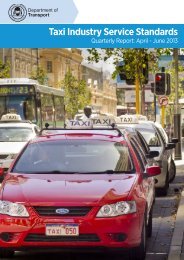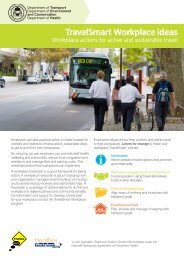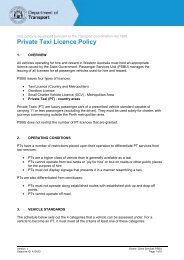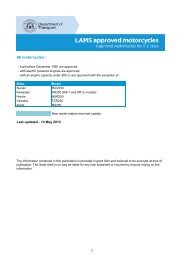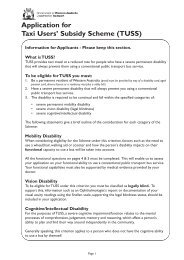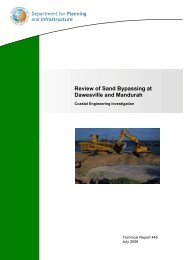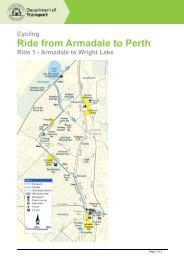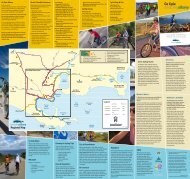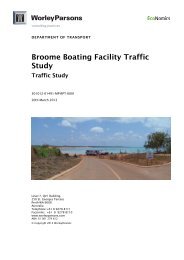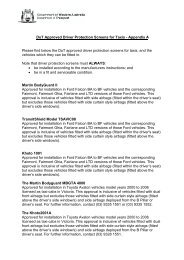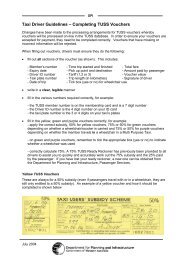Department of Transport Annual Report 2010 - 2011
Department of Transport Annual Report 2010 - 2011
Department of Transport Annual Report 2010 - 2011
Create successful ePaper yourself
Turn your PDF publications into a flip-book with our unique Google optimized e-Paper software.
<strong>Department</strong>al desired outcome 3: Integrated transport systems that<br />
facilitate economic development.<br />
The transport function is integral to business and commerce, and important for<br />
social interaction and connecting communities. Therefore a major focus for DoT is<br />
on strategic transport policy and planning across the range <strong>of</strong> public and commercial<br />
transport systems that service Western Australia.<br />
DoT, through its Policy, Planning and Investment division, develops, integrates and<br />
regulates the State’s transport systems and infrastructure.<br />
Through its policy and planning role, DoT determines the location <strong>of</strong> major transport<br />
routes and infrastructure, their suitability for a range <strong>of</strong> transport services and how<br />
each integrates into the broader transport system for boats, trains, planes and<br />
vehicles.<br />
DoT measures its effectiveness in meeting this outcome through measuring:<br />
Effectiveness indicator: Percentage <strong>of</strong> containerised freight transported<br />
via rail in relation to total metropolitan container movements to and from<br />
Fremantle port.<br />
As the lead agency in the planning <strong>of</strong> strategic transport routes and infrastructure,<br />
DoT understands that efficient logistics are essential between major metropolitan<br />
freight generators in order to avoid congestion and bottlenecks. Freight movement<br />
also needs to be balanced with community consideration such as noise, road safety<br />
and amenity.<br />
An example <strong>of</strong> this approach, developed through the Metropolitan Freight Network<br />
Review (MFNR), is the encouragement <strong>of</strong> industry to transport more containerised<br />
freight by rail between Fremantle port and inland terminals in the Kewdale-Forrestfield<br />
region.<br />
The MFNR set a target for containers carried by rail between Fremantle and<br />
Kewdale-Forresfield <strong>of</strong> 15 per cent by 2007-08 and 30 per cent by 2012-13. At<br />
the end <strong>of</strong> 2008-09, container volumes reached 15.1 per cent, however, these<br />
percentages dropped to 11.5 per cent for <strong>2010</strong>-11 due to the long-term effect <strong>of</strong> the<br />
global economic downturn.<br />
The State Government originally provided financial assistance to support the rail<br />
service at $50 per 20ft container in reflection <strong>of</strong> rail’s higher costs than road. The<br />
subsidy reduced to $45 per 20ft container and $95 per 40ft container on 18 May<br />
2009 and on 3 August 2009 the amount per 40ft container further reduced to $90.<br />
The subsidy is paid on loaded containers having their origin or destination in the<br />
metropolitan area. It was expected that the subsidy per container would further<br />
decrease as volumes on rail increased and operational efficiencies were introduced,<br />
however, further evaluation <strong>of</strong> the subsidy for the future may be required due to the<br />
long term effects <strong>of</strong> the global financial crisis.<br />
This indicator provides information on effectiveness and performance <strong>of</strong> the subsidy<br />
DoT paid on behalf <strong>of</strong> Fremantle Port Authority to Intermodal Link Services (ILS) to<br />
effect a modal shift from road to rail for containers transported to and from Fremantle<br />
port for export or import.<br />
To calculate this indicator, data on rail containers is sourced from the North Quay<br />
Rail Terminal and is compared to Fremantle Port Authority’s trade figures for total<br />
containers (excluding those that are transhipped and do not leave the port precinct).<br />
This comparison enables calculation <strong>of</strong> rail’s market share.<br />
Percentage <strong>of</strong><br />
containerised<br />
freight transported<br />
by rail in relation to<br />
total metropolitan<br />
container<br />
movements to and<br />
from Fremantle<br />
port.<br />
2007-08<br />
actual<br />
2008-09<br />
actual<br />
2009-10<br />
actual<br />
<strong>2010</strong>-11<br />
target<br />
<strong>2010</strong>-11<br />
actual<br />
13.3% 15.1% 10.9% 16.0% 11.5%<br />
Reasons for<br />
significant<br />
variance<br />
The global economic<br />
downturn in trade has<br />
impacted significantly<br />
on rail volumes<br />
through loss <strong>of</strong> certain<br />
trades and intense<br />
competition from the<br />
road transport sector.<br />
107



